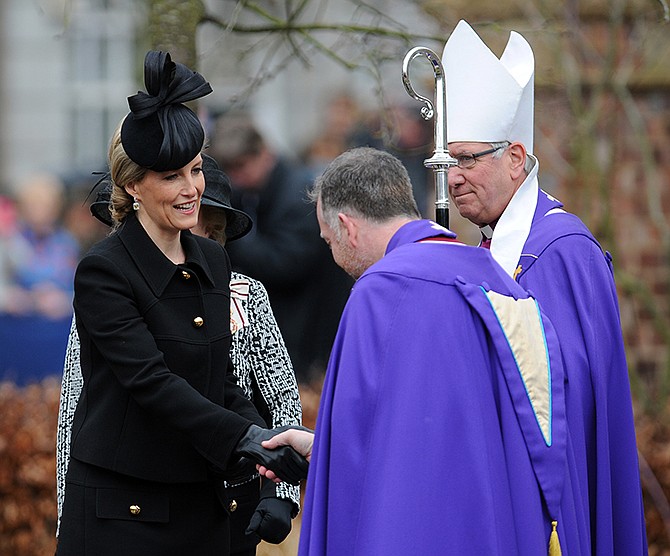LEICESTER, England (AP) - A maligned monarch found under a parking lot was buried in pomp Thursday, as Britain embraced comeback King Richard III, a long-reviled ruler who is experiencing a remarkable posthumous renaissance.
Royalty, religious leaders and actor Benedict Cumberbatch joined archaeologists, Richard's distant relatives and curious Britons for a service in Leicester Cathedral that saw Richard's bones buried with dignity, 530 years after his violent death.
"Richard's posthumous reputation has been less than glorious," Gordon Campbell, the University of Leicester's public orator, noted with understatement about a man whose name was long a byword for villainy.
But now, Campbell said, he has "the greatest following of all English monarchs" apart from Queen Elizabeth II.
Twenty first-century Britain has enthusiastically embraced the story of the medieval king whose battle-scarred skeleton was found under a parking lot in Leicester in 2012.
Thousands came to view his coffin ahead of Thursday's service, which was televised live.
In his sermon, Bishop of Leicester Tim Stevens said the discovery of the skeleton "has broken open not just a car park, but a nation's story."
Richard, he said, belongs not just to archaeologists and historians, "but to all of us."
The service was the culmination of a wave of Richard-mania that has been building since archaeologists looking for Richard dug up a skeleton with a distinctively curved spine.
Scientific sleuthing - including radiocarbon dating, bone analysis and DNA tests - confirmed the remains belonged to the long-lost king, who died at the Battle of Bosworth, near Leicester, in 1485.
The victor, Henry Tudor, went on to reign as King Henry VII and founded the Tudor dynasty.
Richard was buried, without a coffin, in a church that was later demolished. For centuries his image was defined by William Shakespeare's "Richard III": a hunchbacked, power-hungry tyrant who murdered his two young nephews because they were rivals for the crown.
Some historians argue Richard was a relatively enlightened monarch whose reign between 1483 and 1485 saw reforms including the introduction of the right to bail and the lifting of restrictions on books and printing presses.
Many of those who this week came to Leicester, 100 miles north of London, are unabashed Richard fans, ecstatic that he is finally getting his due.
Michele Wild, from the central England city of Birmingham, lined up for two-and-a-half hours to view the coffin before it was buried.
"It was one of those queues where you don't mind queuing," she said. "You feel like you're part of a silent protest about the Tudor propaganda that has been maligning him for 500 years."
Richard's fans and foes alike agreed Thursday's service was a historic occasion. Elizabeth has ruled for 63 years, and most Britons have never seen a king buried.
The service - not a funeral, organizers stressed, since he probably had a simple one in 1485 - borrowed from 15th-century rites, with Latin and plainsong amid the modern hymns.
There was star power, too, as Cumberbatch - who plays Richard III in the BBC's Shakespearean TV series "The Hollow Crown" - read a poem by Poet Laureate Carol Ann Duffy.
University of Leicester genealogists, leaving no Richard-related stone unturned, have identified Cumberbatch as the late king's second cousin, 16 times removed.
"Grant me the carving of my name," Cumberbatch read, of a king who lay for centuries in an unmarked and forgotten grave.
That wish was granted. In a climax of simple dignity, the king's oak coffin was lowered by a group of soldier pallbearers into a grave in the cathedral floor, surrounded by black Swaledale stone carved with his name: "Richard III."
Richard remains a contentious figure. The current queen - a distant relative, though not a descendant - did not attend the service. She sent her daughter-in-law Sophie, Countess of Wessex, to represent the royal family.
Elizabeth wrote a note for the order of service, noting neutrally that the reburial "is an event of great national and international significance."
"Today we recognize a king who lived through turbulent times and whose Christian faith sustained him in life and death," the queen wrote.

